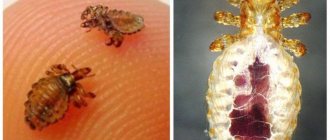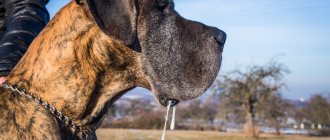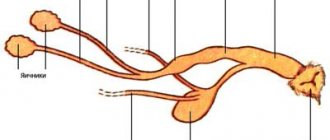Just like people, pets often suffer from digestive problems due to illness or poor dietary choices. Quite common, bloating in a dog's abdomen can be either a sign of feeding problems or a serious and sometimes fatal problem. If the animal has barely noticeable bloating, which goes away after taking the medications, the owners will simply have to reconsider their attitude to the dog’s diet. But if the condition worsens and the bloating increases, this already becomes a threatening sign, and the owners need to urgently seek veterinary help, otherwise the dog may die.
What is ascites in a dog
What is ascites in a dog
Ascites in dogs (dropsy) is a pathological condition accompanied by the accumulation of a large amount of free fluid in the abdominal cavity of the animal. It creates excess pressure on internal organs and interferes with their normal functioning.
The fluid that accumulates in the dog's abdomen can be transudate, exudate, or modified transudate. And its volume can reach 20 liters.
Causes and types of ascites
Ascites in dogs is not an independent disease and always develops as a result of serious inflammatory and non-inflammatory pathologies that impair absorption and blood circulation.
The main causes of dropsy include:
- Kidney diseases. This organ acts as a filter that removes toxins. Kidney pathologies lead to malfunction of the kidneys, which results in fluid stagnation.
- Parasitic and infectious diseases. Due to the activity of pathogenic microorganisms, toxins are released that trigger inflammatory processes.
- Injuries to the abdominal cavity, causing inflammation, swelling or intracavitary bleeding.
- Oncological diseases. Cancer cells are characterized by rapid growth of fibers of the emerging tumor. When placed in the internal organs, the neoplasm provokes a violation of the outflow of lymph, as a result of which fluid can accumulate in the peritoneum.
- Pathologies of the heart muscle. In heart failure, the heart cannot cope with pumping the required volume of blood, which results in dropsy.
- Liver diseases. This organ passes impressive volumes of blood and lymph. Liver dysfunction is fraught with filtration failure and stagnation, causing ascites.
- Peritonitis. The pathology is accompanied by a loss of elasticity of the peritoneal muscles, making it difficult to remove fluid. The result is dropsy.
- Unbalanced diet with high sodium content and lack of proteins and vitamins.
Ascites is not divided into types and may differ in the degree of inhibition of certain organs. But usually dropsy provokes disruption of the functioning of the entire body.
Symptoms and dangers
Ascites in a dog: symptoms
Symptoms of dropsy depend on the severity of the pathology and the volume of fluid accumulated in the peritoneum. The most characteristic sign of ascites in dogs is a symmetrically distended abdomen.
With dropsy, a lot of fluid accumulates in the pet’s peritoneum and when the body position changes, the belly takes on a different shape. If you lay a dog on its back, its belly will spread out to the sides, like a frog's. If the dog is placed on its hind legs, the belly will drop down and take on a pear-shaped shape.
You can suspect ascites in a dog based on such characteristic symptoms as:
- decreased activity;
- loss of appetite (anorexia);
- weight gain;
- vomit;
- dyspnea;
- swelling;
- copious diuresis;
- gait disturbance;
- increased thirst;
- moaning sounds when lying down;
- atrophy of muscle mass.
Difficulty breathing (or shortness of breath) can also occur due to swelling in the abdomen putting pressure on the chest, or due to the associated accumulation of fluid in the space between the chest wall and the lungs (called pleural effusion). Male animals sometimes experience fluid accumulation in the scrotum or penis.
With ascites, the dog's mucous membranes change in color. Due to the lack of oxygen caused by the abundance of fluid, they become bluish, but if the liver is damaged, they can turn yellow.
On a note! With dropsy, dogs often experience impaired swallowing reflexes and difficulty chewing food.
In advanced stages of ascites, up to 20 liters of fluid accumulates in the animal’s peritoneum, putting strong pressure on the internal organs. Due to the enormous load, the dog’s concomitant diseases worsen and it may die.
Treatment options
Treatment at home is only possible in cases where it is known for sure that the stomach is swollen due to food that is unnatural for the dog. Veterinary drugs are used - anti-flatulence agents and sorbents.
In other situations, treating bloating at home is dangerous, since the slightest delay can cost the animal its life. Only after an accurate diagnosis will the veterinarian know whether it is possible to expel the worms, whether an urgent operation is needed, or whether it is possible to limit oneself to drug therapy.
Any independent treatment can aggravate the course of the disease so much that it will lead to a severe deterioration in health and death of the pet.
Diagnostics
If ascites is suspected, it is recommended to take the dog to the clinic for additional tests. A preliminary diagnosis is made by examination and palpation of the abdomen. The presence of a small amount of fluid in the dog's abdomen can be confirmed using an ultrasound or x-ray. Transudate blurs the image, creating a “frosted glass” effect.
To determine the causes of ascites, the dog is additionally prescribed:
- Analysis of urine;
- echocardiography (ultrasound of the heart);
- biochemical and clinical blood test;
- X-ray of the chest and/or abdominal cavity.
To determine the cause of the accumulation of ascitic fluid, the dog is prescribed a bacteriological and cytological examination of the transudate. It is taken through a puncture of the peritoneal wall with a special syringe. This procedure under local anesthesia is called abdominocentesis. If a sample taken by puncture of the abdominal wall contains a light-straw-colored liquid without a strong odor, it is ascites.
Important! When puncturing the abdominal wall, you cannot pump out a large amount of fluid at once. This will not only not lead to a cure for dropsy, but will also cause the dog’s condition to worsen.
A correctly performed abdominocentesis procedure is absolutely safe and helps to identify the disease that provoked ascites. Thus, with peritonitis, a high concentration of glucose is observed in the ascitic fluid. Excess bilirubin indicates bowel or gallbladder disease.
With infections or cirrhosis of the liver, a decrease in the level of total protein is recorded, and with tumors in the abdominal cavity or heart failure, its increase.
When to see a doctor
You should contact a specialist for help when:
- rumbling is accompanied by pain in the dog;
- there is a suspicion of helminthic infestations;
- loss of appetite;
- the stomach is very bloated, the dog looks tense;
- the pet develops digestive problems, manifested in vomiting, diarrhea, constipation;
- Together with the listed symptoms, the animal is lethargic, apathetic, loses weight, and there is bloody discharge in the stool.
What to feed
For ascites, a temporary diet is recommended for the dog, which includes:
- reducing the amount of water and salt consumed;
- feeding boiled or steamed foods high in protein;
- introduction of vitamin and mineral supplements selected by a veterinarian.
The diet of a dog suffering from ascites should be dominated by lean meats, low-fat fermented milk products and porridge cooked in water. It is also recommended to give your pet thermally processed vegetables, with the exception of those that cause bloating (radish, cabbage, legumes). With ascites, it is advisable to completely exclude sweets, cottage cheese, spices and sausages from the dog’s diet.
It is recommended that an animal eating dry food be temporarily switched to a medicinal line produced specifically for dogs with a sensitive digestive tract. To prevent intestinal disorders and allergic reactions, it is advisable to choose products from an already familiar manufacturer.
We recommend reading:
- Enterosgel for dogs with diarrhea and vomiting
- Why does a dog eat poop and why is it dangerous?
Prevention
There are no specific methods to prevent the development of ascites in dogs. Therefore, owners are recommended to take measures aimed at protecting their pets from the main causes of dropsy.
To do this you should:
- Protect your dog from injury during walks.
- Avoid contact between your pet and other animals to avoid fights and infections.
- Adhere to the schedule of vaccinations and antiparasitic treatments.
- Do not ignore the appearance of strange tumors on the animal’s body.
- Do not neglect annual medical examinations for the presence of hidden systemic diseases.
- Stick to a feeding schedule, avoid overfeeding and provide a balanced diet enriched with nutrients.
Important! Some pathologies appear only when most of the organ is affected. Therefore, in the presence of chronic diseases, annual preventive examinations are recommended for your pet, even in a state of stable remission.
Other skin diseases
Allergy
There are three types of allergies in dogs:
- Allergy to flea saliva;
- Food allergies;
- Atopy.
Allergy to flea saliva, or flea allergic dermatitis, occurs in animals more often than any other type of allergy. Flea saliva is a protein, and in sensitive animals, when it enters the bloodstream, it causes characteristic symptoms. At the same time, it can be extremely difficult to find a flea on a dog, since their habitat is not the skin of animals, but the environment. Just one flea bite can cause a reaction. Food allergies, on the contrary, are the rarest type of allergy. Despite the common misconception about the high allergenicity of chicken in the diet of animals, dietary protein very rarely causes any reactions. Atopy is the second most common type of allergy. Allergens are various air components - dust, pollen, bed mites, etc. There are no tests that can confirm the type of allergy. The diagnosis is made only by exclusion.
Symptoms
For all three types, the symptoms will be extremely similar. The first sign of an allergy is itching. It will be accompanied by 80-90% of all cases. On the dog's body you can notice redness, bald patches, scratches, pimples, pustules, crusts, and scales. Brown spots on the dog’s belly, that is, darkening of the skin, will be the result of a post-inflammatory reaction.
Treatment
Treatment in most cases is also a diagnostic method. Antiparasitic treatments are used to treat and eliminate allergies to flea saliva. Most often, drops are used on the withers, preferably with a repellent effect. For diagnostics, drops are used for at least 2-3 months without interruption; if the treatment effect is good, they remain constant. The room where the dog lives is also treated at the same time, since fleas like to live in genital crevices, in rugs, and under baseboards. To treat the premises, special solutions for washing floors and surfaces, as well as antiparasitic sprays, are used. If, despite these manipulations, the effect is weak, the dog is still itching, there are lesions on the skin, then the elimination of food allergies begins. For this purpose, a special elimination diet is prescribed. It includes either foods that the dog has never eaten before in its life, or food based on protein hydrolysate. If the animal shows improvement, but after returning the old food a relapse occurs, then the diagnosis of food allergy has been established. Now you need to choose a new diet, and the animal’s symptoms will disappear.
If all of the above measures do not bring any success, the dog is diagnosed with atopy. Its treatment is extremely difficult; basically all measures are only supportive in nature to eliminate itching, inflammation, infection and dry skin. Allergen-specific immunotherapy can also be used for treatment. An individual vaccine is prepared for the animal, which will help the body not react to the identified allergens. Unfortunately, it is almost impossible to achieve 100% effectiveness, and such vaccination must be repeated constantly throughout life.
Autoimmune diseases
There are many different skin diseases in dogs caused by autoimmune processes, most of them are still not fully understood. Several of the most common conditions can be noted:
Pemphigus foliaceus
A disease of the immune system in which the skin's own immune cells attack skin cells. It is more common in Akita and Chow Chow dogs, although it can occur in other breeds.
Symptoms
The main symptom of this disease is the detection of pustules on the body. This is often difficult to do, since the pustules are covered with thick hair and burst easily. Secondary lesions are observed more often - crusts, scales, bald patches. Typical locations are around the eyes and on the nose. Sometimes the only sign is thickened paw pads with crusts.
Treatment
The main treatment is to suppress the body's immunity; for this purpose, glucocorticoids and immunosuppressants are prescribed. Antibacterial shampoos are used topically to soak the crusts and eliminate the infection. In case of a serious infection, oral antibiotics are prescribed.
Discoid lupus erythematosus
It also occurs due to a failure in one’s own immune system; there is no breed predisposition.
Symptoms
The main symptoms include whitening of the nose, the formation of crusts and ulcers on it and near it. The skin and fur around the eyes, lips, and fingertips may also lighten.
Treatment
Treatment also involves suppressing the immune system and eliminating infection. If the lesions are very small, you can try using only topical creams.











